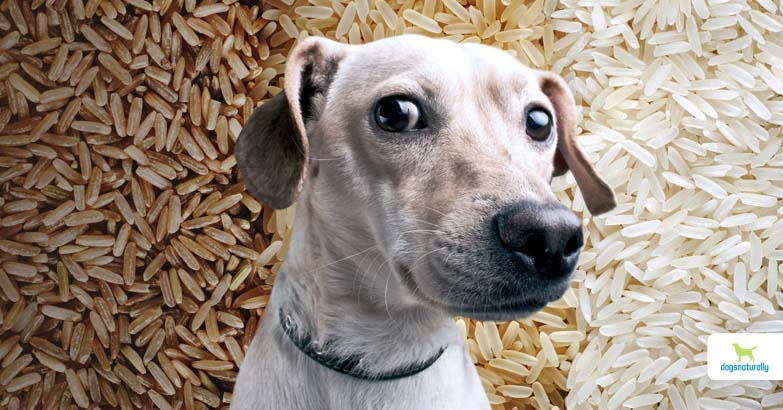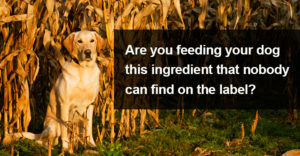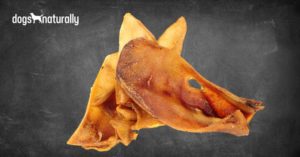Instead of “can dogs eat rice?” the question should really be “should dogs eat rice?” And the answer is quite simple: no. Physiologically a dog can digest rice. Rice doesn’t contain fat, salt or cholesterol … and it’s loaded with carbohydrates that provide energy. But as long as a dog has plenty of meat, healthy fats and some nutrient-rich vegetables and fruit, he doesn’t need carbs.
Let’s start with some basics.
What Is Rice?
Rice is one of the oldest cereal grains and dates back 5,000 years. It’s actually an edible seed from a type of grass. And there are thousands of varieties. Other types of grain are wheat, oats, corn, barley and rye.
Rice is a staple in the diets of billions of people in many cultures around the world. It’s cheap and it’s prevalent. But it’s devoid of vitamins, minerals and phytonutrients. Its only value is as a carbohydrate for energy. And it must be cooked or milled into flour to be eaten.
What Are The Nutrients In Rice For Dogs?
Rice is a carbohydrate so it doesn’t have a lot of other nutrients. Dogs don’t need carbs … but if you want to feed carbs, there are better, more nutritious sources of carbs than rice.
Brown rice has more nutrients than white rice. It has fiber, manganese and small amounts of iron, and B vitamins like niacin. But when brown rice is milled, milling removes the outer bran and germ, along with most of its fiber, iron and niacin leaving a grain of white rice with even fewer nutrients. Then white rice is enriched with additional nutrients like niacin, iron and B vitamins like folic acid, niacin and thiamine to replace those removed (1).
Manganese is a mineral important in a dog’s growth. In brown rice, 1/2 cup provides 48% of the recommended daily intake (RDI) for people, but white rice has less than half at 13%. White rice has 6% of the RDI of iron, along with fiber and B vitamins including thiamin, niacin and riboflavin.
Brown rice might be higher in antioxidants and essential amino acids than white rice. But so are green leafy vegetables and meat, poultry, eggs and fish … with fewer calories and more benefits. And they also provide your dog with energy.
Does Rice Affect Taurine Levels In Dogs?
Yes, it does – but not in a good way. A 2003 German study found that “blood taurine concentrations were lower in dogs fed diets containing whole grain rice, rice bran or barley.” They found that the lowest taurine levels were seen in dogs fed lamb or lamb meal and rice diets (2). In addition, they found that blood concentrations for the methionine and cysteine were also lower in dogs fed a diet of animal or turkey meals, as well as whole grain rice, rice bran or barley. Methionine, an essential amino acid obtained from a dog’s diet, and cysteine, are both needed for many things including cellular function and the production of glutathione and taurine. Taurine is an amino acid needed by dogs for eyes, reproduction and most importantly, heart function.
Especially noteworthy was the finding that 15 of the 131 healthy dogs in the study had taurine levels equal to or even lower than levels in dogs fed a taurine-deprived diet in an earlier 2000 study.
Can Dogs Digest Rice?
Yes. A dog has the ability to digest rice and other carbohydrates. While humans produce the digestive enzyme amylase in the mouth, dogs get amylase from the pancreas.
Then, if you look at how a dog’s body (and a human’s) functions and processes carbohydrates you will see that the body has 8 hormones to raise blood sugar in times of famine … but only one to lower it … insulin. That’s because in the primordial world there was never much excess. There was a minimal need to address the rare spike in blood sugar and have it saved as fat.
Contrast that with the industrial age and food processing of today … and the diet of today’s domestic dog. Dogs are inundated with a processed diet of carbohydrates causing the body to store excess as fat … and that leads to an incredible number of overweight dogs and digestive problems.
Is Rice Good For Dogs With Diarrhea?
It’s common for vets to recommend feeding a bland diet of rice and boiled chicken or hamburger to dogs with diarrhea. That’s because these foods are easy to digest when the gut is stressed. But there are better choices than rice … including fibrous foods like pumpkin, or the diarrhea soup described in the article below.
RELATED: How to stop dog diarrhea fast …
Can Dogs Eat Carbohydrates?
Yes, they can. But let’s consider what animal nutritionist Dr Richard Patton PhD has to say about animals and carbohydrates. “If you analyze anything that might constitute food or nourishment, anywhere in the world, it will be low in starch and sugar. The average starch and sugar content of meat, fish, eggs, insects, plants, fruits, berries, and vegetables is about 4%.”
But most dry pet food is about 40% carbohydrate, increasing the demand for insulin in a dog’s body … daily. And that can happen multiple times a day with additional feedings of commercial kibble.
So, yes, dogs can eat and digest carbs and store the excess as fat, but it shouldn’t be a substantial part of their diet. And there’s another problem with feeding dogs rice.
Rice Can Increase Risk Of Diabetes In Dogs
The carbs in rice are turned into blood sugar quite quickly. Rapid spikes from a constant diet of carbohydrates increase the demand for insulin in your dog. When this is a regular occurrence, it can stress the pancreas that produces the insulin. There was a substantial study done in 2012 that found those who ate the most white rice had a higher risk of Type 2 diabetes (3). Insulin functions the same way in dogs as it does in people.
So it begs another question.
Why Is There Rice In Dog Food?
Rice is used as filler in processed dog food because it’s cheap. But here are the problems with that:
- Rice is missing key nutrients , which are then added in the form of synthetic vitamins, minerals and amino acids which aren’t properly recognized in your dog’s body
- Rice can contain mytotoxins that are byproducts of mold and fungus
- AFB1 is an aflatoxin, a well-known mycotoxin, that the FDA calls “the most potent known natural carcinogen.”
- It’s not a complete protein source (hence the addition of amino acids)
- Most rice is genetically modified (GMO), and GMOs destroy good bacteria in your dog’s gut
- Pesticides are sprayed on crops like rice that are then used to make dog food
- Starches like rice make up a huge percentage of the ingredients in dog food so there’s less need for more nutritional … and more expensive … ingredients like meat, poultry, fish and eggs.
And why would dogs be fed something that can’t be eaten in its natural (uncooked) state?
Can Dogs Eat Uncooked Rice?
No … and no one should. This is another consideration when you ask can dogs eat rice?
In the wild, vegetation-eating animals, like deer, seek out food like leaves, roots or berries. Predatory animals, like the dog or wolf, pull raw meat from their prey carcass. They’ll eat contents from the stomach which have begun digestion (fermentation) like fruits, vegetables, leaves, etc.
Raw grains from the field like wheat, corn, barley … and rice from the rice paddies … have no appeal unless they’ve been converted to something more edible by milling, soaking, sprouting, cooking or baking.
Otherwise, raw grains travel through the body intact … with a hard outer shell for protection. Anything in that protected kernel can’t be digested or absorbed. You’ll find it in the stool in the same form as it went in.
And there’s another problem with rice. It is highly probable it contains arsenic.
Is Rice Safe For Dogs?
No, it’s not. And that’s because it’s common to find arsenic in rice. Widespread pollution has led to a major increase in the amount of arsenic in the environment. Organic arsenic is found in plant and animal tissue. But inorganic arsenic, the more toxic type, is found in rocks and soil and dissolved in water (4).
Arsenic is passed into the environment through pesticides and herbicides, wood preservatives, phosphate fertilizers, industrial waste, mining activities, coal burning and smelting. It often drains into the groundwater that feeds wells and is a source for irrigation on farms.
And rice is particularly at risk because:
- Paddy fields are irrigated with contaminated water (5)
- Arsenic can accumulate in the soil of paddy fields
- Rice appears to absorb more arsenic from water than other crops (6)
- If cooking water is contaminated, rice will absorb even more arsenic
What Are The Health Effects Of Arsenic In Dogs?
Here are some risks that eating arsenic can cause:
- Cancer (7)
- Vascular disease by narrowing or blocking blood vessels
- High blood pressure
- Heart disease
- Diabetes
- Neurotoxicity and diminished brain function
And arsenic can be passed from mother to baby or mother dog to puppy, leading to birth defects and irregular development.
High doses of arsenic are toxic … and dietary doses are thought to be okay. But eating it over the long term can cause problems. Most commercial dog foods contain rice and dogs eat them every day for their entire life. And that’s a problem.
So, can dogs eat rice … or should they?
No. Just because they can digest it, doesn’t mean they should eat it. There are better sources of vitamins, minerals and energy than rice … like animal proteins, healthy fats, fruits and vegetables. And these sources offer far less chance of your dog gaining weight or becoming sick from arsenic poisoning or low taurine levels.
References:
1. Leon Guerrero RT, et al. White rice sold in Hawaii, Guam, and Saipan often lacks nutrient enrichment. J Am Diet Assoc. 2009 Oct;109(10):1738-43.
2. Delaney SJ, Kass PH, Rogers QR, Fascetti AJ. Plasma and whole blood taurine in normal dogs of varying size fed commercially prepared food. J Anim Physiol Anim Nutr (Berl). 2003 Jun;87(5-6):236-44.
3. Hu EA, et al. White rice consumption and risk of type 2 diabetes: meta-analysis and systematic review. BMJ. 2012 Mar 15;344:e1454.
4. Carbonell-Barrachina AA, et al. Presence of arsenic in agricultural products from arsenic-endemic areas and strategies to reduce arsenic intake in rural villages. Mol Nutr Food Res. 2009 May;53(5):531-41.
5. Rahman MA, Hasegawa H. High levels of inorganic arsenic in rice in areas where arsenic-contaminated water is used for irrigation and cooking. Sci Total Environ. 2011 Oct 15;409(22):4645-55. d
6. Williams PN, et al. Greatly enhanced arsenic shoot assimilation in rice leads to elevated grain levels compared to wheat and barley. Environ Sci Technol. 2007 Oct 1;41(19):6854-9.
7. Tapio S, Grosche B. Arsenic in the aetiology of cancer. Mutat Res. 2006 Jun;612(3):215-246.












